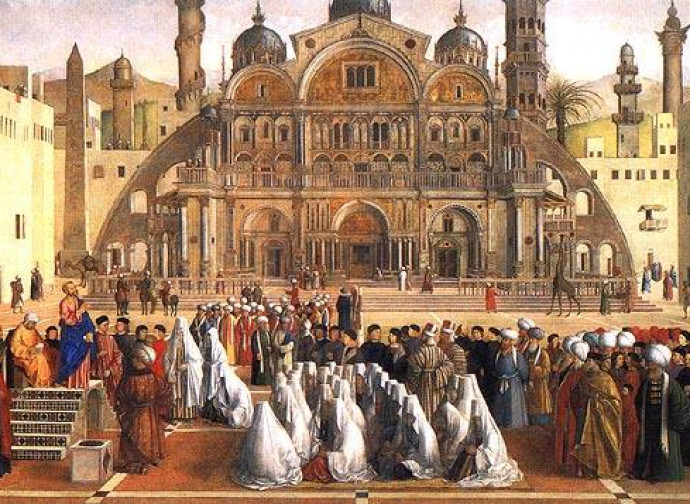Saint Mark
He wrote the second Gospel on the direct appeal of the first Christians of Rome, attracted by the teachings of St. Peter.

If St. Matthew writes for his fellow Jews (as we gather from his many references to Old Testament quotations revealing that Jesus is the Messiah), St. Mark wrote the second Gospel on the direct appeal of the first Christians of Rome, attracted by the teachings of St. Peter. This is well reported in the Church History by Eusebius of Caesarea (c. 265-340), who on this subject referenced the writings of some of the very first Fathers of the Church, such as St. Papias of Hierapolis (c. 70-130) and Clement of Alexandria (c. 150-215). After having spoken of Simon Magus’ deceptions, Eusebius writes of the community of Rome: “Instead, the light of piety shone so brightly in the minds of those who listened to Peter, that they were not satisfied to only have listened to him once or to have received orally the teaching of the divine message, but with all sorts of prayers they begged Mark, whose Gospel has reached us, and who was a follower of Peter, to leave a written report of the teaching transmitted to them [...]”.
This fact confirms the importance of Mark in the nascent Church, in which he was a faithful interpreter of Peter. The latter “became aware of the fact by revelation of the Spirit and, having rejoiced in their zeal, validated the text for reading in the churches”. The Prince of the Apostles himself names Mark in his first letter, calling him “my son” (1 Pet 5-13), perhaps because it was he who administered his Baptism and certainly because he was his spiritual father. Mark and Peter, according to another report by Eusebius, arrived for the first time in Rome “at the beginning of the reign of Claudius” (41-54), so around 41. The Gospel is written around 50-60 and presents a particular detail that can be said to be autobiographical, concerning the circumstances immediately following the arrest of Jesus in Gethsemane: “A young man, however, followed him, covered only with a sheet, and they stopped him. But he shed the sheet and ran away naked” (Mk 14:51-52). Tradition has identified that young man as the second evangelist himself, the only one to report this detail.
According to a well-established tradition, moreover, the Upper Room belonged to Mark’s family, well known to the Twelve (cf. Acts 12:12; Peter, imprisoned by Herod Agrippa and freed by the angel, went to the house of Mark's mother, “where there were a good number of people gathered in prayer”). Thanks to the Acts of the Apostles and the Pauline letters, we know that Mark was also Paul's collaborator and Barnabas' cousin. He helped the Apostle of the Gentiles in preaching in Antioch and Salamis, but once in Pamphylia he separated from Paul and his cousin to return to Jerusalem. It is not known why the then young Mark came to this decision. But it is known that Paul, at the beginning of his second apostolic journey (50-52), preferred not to take Mark with him again, in disagreement with Barnabas, from whom he separated (Acts 15:36-41). In any case the evangelist was later fully reconciled with Paul, who sent Mark's greetings in the Letter to the Colossians (composed around 62) and then writing to Timothy urged him: “Take Mark with you, for he is useful to me in the ministry”.
In the meantime Mark had founded the Church of Alexandria in Egypt, where he died and where he had been sent by Peter, according to a very ancient tradition. Mark's symbol is the winged lion, mainly because his is the Gospel in which Christ prophesied several times His own Resurrection (Mk 8:31; Mk 9:9; Mk 9:31; Mk 10:34; Mk 14:28), symbolically represented by the lion's strength. The animal then became the symbol of Venice, where the splendid St. Mark's Basilica still holds the saint’s relics. His remains arrived in Venice after having been stolen in 828 by two Venetian merchants, who used a stratagem to evade being caught by the Muslims in Alexandria.
Mark himself was shipwrecked in the lagoons of the future Venice and it is said that an angel in a dream told him: Pax tibi Marce, evangelist meus. Hic requiescet corpus tuum, “Peace to you Mark, my evangelist. Here shall thy body rest”.
Patron of: breeders, shoemakers, leather tanners, pharmacists, interpreters, notaries, opticians, secretaries, glassmakers; invoked for the harvest and against scabies; Veneto, Egypt




